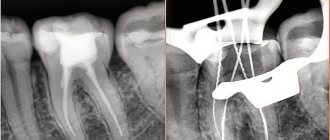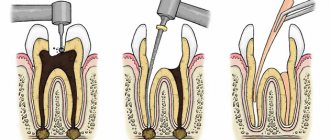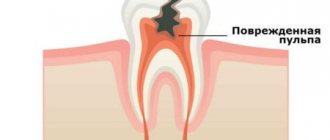Cleaning the tooth canals is a procedure for removing microparticles of the inflamed pulp from the roots, i.e. affected tissues. This is a particularly labor-intensive process, since the final effect of caries treatment depends on the quality of the work.
Clinical case: a patient has caries that has developed into pulpitis. When opening the tooth, the dentist diagnosed an infection and a severe inflammatory process; it was recommended to remove dead pulp tissue from the roots. If the work is not performed perfectly, an infection gets into the roots, a filling is placed on top, and the pathological process already develops under a thick layer of filling material. The toothache does not subside, the patient goes to the doctor again or endures the pain, quenching it with medications, and eventually loses the tooth. That is why, in case of caries, pulpitis and other problems, it is important to contact trusted doctors who perform high-quality root cleaning. It is advisable for the dentist to work with a microscope - multiple magnification allows you to monitor the process of cleaning the canals from remnants of pulp tissue.
One tooth may have two or more tubules, which are localized in the layers of the periodontium. The main task of the canals is to be a connecting link between the crown pulp and the nerves.
More than 10 years ago, deep caries and advanced pulpitis were the reasons for removing a unit, but now, thanks to effective cleaning and treatment of the canals, it is possible not only to preserve the crown, but also to restore its integrity to an ideal result.
When is tooth canal cleaning necessary?
Here are three common cases when a patient is required to have canal cleaning:
- Before installing the prosthesis on the tooth, the unit is depulped and ground down so that a crown can subsequently be installed on it;
- When diagnosing pulpitis (inflammation of pulp tissue). Usually pulpitis is a consequence of advanced caries and infection. The problem is accompanied by acute pain; it is painful for the patient to chew on the side of the pathological tooth, which indicates severe inflammation inside the tooth;
- If a person has been diagnosed with periodontitis - inflammation of the tissues around the tooth. Usually the problem is a consequence of untreated caries and a dynamically spreading infection.
Internal tissues and pulp become inflamed due to the penetration of pathogenic microorganisms. They can also get inside due to mechanical injuries (chipping off a piece of a tooth, splitting a crown due to a blow or fall, tooth dislocation), gum disease.
Note! Pain is not always the only signal to remove the pulp and clean the tubules of dead granules. Very often, cell death occurs without pronounced symptoms, when the tooth stops hurting, and the inflammatory process is already actively developing inside it. A visit to the dentist and a complete examination of the oral cavity will help you understand that there is a purulent-inflammatory process in the tooth.
It is important to thoroughly clean the canals from pulp residues, since pathogenic microflora will still provoke purulent-inflammatory processes. Therefore, it is advisable to remove inflamed tissue not only from the canals, but also from the crown part of the tooth.
In particularly complex and advanced cases, partial pulp resection is prescribed. If the dentist does not consider this method, unfortunately, the tooth is removed.
Dentistry for those who love to smile
+7
Make an appointment
Why does pain occur?
Caries first attacks the hardest tooth tissue, the enamel. Then the dentin underneath begins to deteriorate. When the carious cavity reaches a large size, the infection will reach the pulp, ending in the root canals. An infected pulp causes increased blood flow, pressure in it increases and, not finding a way out, leads to painful sensations. Thus, the need arises for the treatment of pulpitis or periodontitis .
The pulp can become infected for other reasons:
- due to mechanical damage resulting from an impact;
- with impaired blood circulation in the jaw area;
- with neuralgia of various origins;
- due to infection spreading from periodontal pockets in patients with periodontal disease and periodontitis.
Preparing for channel cleaning
To assess the condition and structure of the root system, the patient is prescribed a preliminary diagnosis:
- CT scan;
- radiography;
- radiography;
After this, the dentist chooses a cleaning tactic and a special tool for the job.
Before opening the coronal part, local anesthesia is administered, since in a state of inflammation, internal structures can provoke acute pain. In this case, the dentist administers the anesthetic using the following methods:
- point or infiltration, that is, when injections are made into the projection of the apexes. An injection into the cancellous bone using the same infiltration method will also numb the area well;
- The conduction technique involves anesthesia of the nerve branch that surrounds the neighboring units. Anesthesia also affects some of the soft tissues, so after the injection and treatment, the patient may continue to experience unpleasant sensations in the immobilized part of the mouth for a long time.
Should I see a doctor if I have pain after root canal cleaning?
Root canal cleaning is a surgical procedure that is performed when infection occurs and inflammation develops. Most often it is performed for pulpitis or periodontitis. This affects the soft tissues of the oral cavity. It should be borne in mind that in this case, already inflamed tissues are treated, and after cleaning, the inflammation persists for several days.
Therefore, a slight aching pain after therapy is normal and is not considered a cause for concern. At night, the pain often intensifies.
After a couple of days, the healing process enters an active phase, the pain slowly and gradually decreases, although pain and discomfort may persist for several weeks. They can be reduced or eliminated through anesthetic medications and rinses.
The pain syndrome can persist for a long time if the patient delays visiting the dentist, as a result of which the inflammation has become extensive and severe. Therefore, it is so important to regularly visit a specialist, undergo preventive examinations and visit a doctor at the first signs of illness. The sooner the problem is detected, the less complex and painful the therapy and rehabilitation will be.
Will root canal cleaning save a tooth that is more than 50% destroyed?
Yes, quite, but instead of installing a composite filling, it is recommended to install a microprosthesis or a ceramic crown. The only difference is in the final stage of the operation.
Clinical case: the patient was diagnosed with advanced caries, which developed into pulpitis. The tooth is badly damaged, but the root is intact. The dentist removes necrotic tissue, qualitatively treats the canal passages, cleans them under a microscope, and then places a microprosthesis or a full-fledged crown.
Why and when is root canal treatment required?
Extensive caries, pulpitis, periodontitis are dental diseases that bring painful suffering to a person and require serious endodontic treatment, which consists of cleaning and filling the canals. Sometimes dentists ask whether it is possible not to fill the canal in case of these diseases. As experts state, this complex canal treatment is necessary and should only be carried out under a microscope, because Only with its help can you fully save the tooth, its functionality and aesthetics. All manipulations performed inside the canals must be carried out by the dentist with increased precision, however, even if the surgical intervention went without incident, not a single person is insured that after some time he will not experience the consequences of such treatment.
Deputy chief physician
Brodsky Sergey Evgenievich
Sign up for a free consultation
+7
All complications of endodontic manipulations are directly related to improper treatment of canals in the teeth and are of the following nature:
- There are no channels found. This situation is possible if the dentist works without a microscope and cannot find the tooth canal because it is additional, too narrow or has an atypical anatomical entrance. When a doctor, due to inexperience or due to the lack of necessary equipment in the clinic, leaves hidden or atypical, too narrow canals in the tooth uncleaned, the inflammatory process begins to develop again in them after a short time.
- The canals are poorly sealed. This consequence of medical manipulations is due to the fact that the dentist discovered narrow canals in the teeth, which is why he was unable to fill them to their entire length. The remaining voids become the site of localization of pathogenic microflora,
- The entire length of the dental canals were not cleaned. It is impossible to completely go through the tooth canal in several cases:
- during repeated endodontic treatment, the dentist cannot remove the remaining fillings from phosphate cement, a very durable material that cannot be removed by mechanical means, solvents and ultrasound;
- age-related changes - with age, the walls of the canals become covered with deposits of dentin-like tissue and dentin, which leads to their narrowing.
- chronic and subacute pulpitis or regular overloads provoked the overgrowth of canal cavities;
- The canals are washed with antiseptics very quickly, without recording the exact time of exposure, and this leads to the fact that the bacterial microflora located in them does not have time to die and provokes the occurrence of repeated inflammation.
The listed consequences speak for themselves about what will happen if one of the canals is not sealed. To prevent repeated inflammation that can lead to tooth loss, dental procedures should only be performed by a qualified dentist with extensive experience. It is precisely these specialists who work in the Moscow clinic Partner-Med, so endodontic treatment of teeth there is guaranteed to end in their salvation.
Canal treatment technique
Questions about how exactly dental canal treatment occurs in order to preserve the dental unit are also of interest to many people. This type of therapy involves the use of various methods, but they all have a standard treatment regimen, which consists of 3 stages and looks approximately like this:
- Providing access to the canal cavity.
- Expansion and formation of the causal channel.
- Complete cleaning of the dental canals from necrotic tissue.
- Permanent sealing with inert material guaranteeing complete sealing.
Manipulations for canal treatment can be compared to a microsurgical operation, because all manipulations are carried out on a microscopic area that has poor visibility for the dentist. These factors require high professionalism and precision from the dentist, so root canal treatment should be carried out only under a microscope and requires a responsible choice of dentistry. A dental clinic must have a dental microscope, without which endodontic treatment is significantly complicated.
Why choose Partner-Med for dental canal treatment
Our clinic has a large number of advantages over other Moscow dentists, so a large number of residents of the capital prefer to get rid of dental problems with us. Reviews from our patients indicate that the following factors play an important role in choosing our clinic:
- free initial appointment;
- constant promotions and discounts on services;
- adequate prices for treatment and a flexible payment system;
- high level of education and many years of experience of our specialists;
- We specialize in endodontic dentistry with the mandatory use of dental microscopes;
- the use of only modern technologies and innovative equipment in all dental procedures.
Just pick up the phone and call us!
+7
We will definitely make you an offer that you cannot refuse!
How to rinse your mouth with baking soda?
Before using baking soda, rinse your mouth with clean water; you can use either warm or cold water. Then they brush their teeth, after which they keep the soda solution in the area of the diseased tooth and gums. After 15 minutes, spit out the solution and do not drink anything for half an hour.
The flux solution is made like this: take a teaspoon of soda into a glass of warm water and stir it until completely dissolved. Rinse the mouth twice a day: in the morning before meals, before going to bed after the last meal. For rinsing, use the entire glass of solution; as a result, two servings (half a liter) will be used per day.
To treat periodontal disease, a solution is made with alum. For a glass of warm water, use one teaspoon of baking soda and a quarter spoon of the same volume of alum. Rinse the mouth with the solution, and massage the swollen alum, apply it to the sore spot and gently massage the gums.
For acute pain, use a soda solution with the addition of salt and eucalyptus oil. Half a glass of warm water is mixed with a teaspoon of soda and two drops of eucalyptus. Water can be replaced with chamomile decoction (if you are not allergic to it). For five days, rinse your mouth with this solution three times a day.
Possible complications of ignoring pain
The sensations that may occur in a pulpless tooth clearly indicate the presence of pathology, which must be eliminated as quickly as possible. Otherwise, infection will lead to quite serious consequences:
- complete destruction and/or loss of the tooth;
- acute or chronic gingivitis (gum disease);
- development of periodontitis (inflammation of the tissue surrounding the root, bone tissue of the alveoli and gums);
- chronic inflammation of the gums;
- the appearance of a cyst.
Ignoring the inflammatory process and delaying contact with the dentist can cause the development of systemic infections, which will spread throughout the body through the bloodstream from the periosteum.
Preventive actions
Dead teeth can be considered problematic (prone to any dental disease except pulpitis), so they require more careful care. To preserve them and prevent pain, it is necessary to carry out prevention:
- Balanced diet
. Daily meals should contain sufficient amounts of essential minerals and vitamins. - Correct and thorough oral hygiene
. Use a toothpaste recommended by your dentist at least twice a day, and use dental floss and mouthwash after each meal. - Regular visits to the dentist
. By visiting the clinic once every three months, you are guaranteed to be able to identify emerging problems with dead teeth. Once or several times a year, it is worth doing cone beam computed tomography (CBCT), which is the best diagnostic technique today. The finished 3D image shows what is impossible to see in targeted and panoramic images. CBCT results allow you to study the condition of the jaws from all sides, turning images on the monitor at any angle. This technique best identifies problems with pulpless teeth even in the initial stages.
At the same time, the best prevention in this case is to avoid the need to remove the roots. Lead a healthy lifestyle, adhere to the recommended diet, regularly take care of your oral cavity, and then you won’t have to look for the answer to the question: why does a dead tooth hurt and what to do about it.
Installing a seal
The task of the doctor who has discovered a tooth damaged by caries is:
- drilling out dead tooth tissue and darkened parts of enamel;
- expansion of the carious cavity;
- checking the condition of the pulp;
- preparing the tooth for filling.
The filling process consists of:
- in disinfecting the drilled cavity and drying it;
- installing a medicinal inlay into the tooth canals;
- installation of a temporary filling;
- A permanent filling is installed when a tooth is cured and the lost parts need to be restored.
What not to do
There is a lot of “harmful” advice that will only worsen the situation. So, what not to do:
- Do not heat. Under no circumstances apply heating pads, scarves, compresses, warming tampons, etc. to a sore tooth.
- Do not apply tablets. You can often come across advice to put an aspirin tablet on a sore tooth, but this can only cause a chemical burn.
- Do not take antibiotics. In the treatment of certain dental diseases, doctors often use antibiotics. But only a specialist can develop an effective and correct regimen for taking them.










